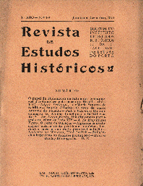

................................
In 1919, the philosopher Leonardo Coimbra, Minister of Education in the government of Domingos Pereira, created the first Faculdade de Letras [School of Arts and Humanities] in Porto, a unique and innovative university institution in a university traditionally specialising in scientific fields. It was from the Institute of Historical Studies of this School that the direction and much of the collaboration of the History of Portugal, known as “de Barcelos”, the first history of the country written by academics, came from. The Faculdade de Letras do Porto [School of Arts and Humanities of Porto] was closed in 1928, but continued to operate until 1931, allowing students who had enrolled in 1927 to complete their degrees.
Revista de Estudos Históricos is considered the first university history journal to be published in Portugal. Created within the Institute of Historical Studies of the first Faculdade de Letras do Porto [School of Arts and Humanities of Porto], this publication was directed by Damião Peres, interim rector and professor at the School. The first issue was a double issue dated January to June 1924. Although it was initially billed as a quarterly journal, it was only published quarterly during its first year. The following year, it became a quarterly publication and, in 1926, its last year of publication, only a single triple issue was published.
At first glance, this publication consisted of ten issues published over three years. Strangely, the last three, which refer to the year 1926, contain a set of critical reviews of works published in the following two years, all signed by Damião Peres, in a section entitled “Bibliography”. The same copies also contain an article by Ludovico de Meneses dated April 1928. This observation leads us to believe that the last volumes do not truly correspond to their date of publication, which was only possible from the end of 1928 or the beginning of 1929. We do not know the reasons for this discrepancy and apparent inconsistency. However, the evidence suggests a longer publication period than the three years suggested by the date on the covers. Published in Porto, this journal, aimed at academics, was not divided into sections. Similarly, we are unaware of other characteristics, such as its print run and cover price. Graphically, the periodical was unattractive, with sporadic illustrations of coins, artefacts, maps and documents, and figures of a purely technical nature.
This work is financed by national funds through FCT - Foundation for Science and Technology, I.P, in the scope of the projects UIDB/04311/2020 and UIDP/04311/2020.
